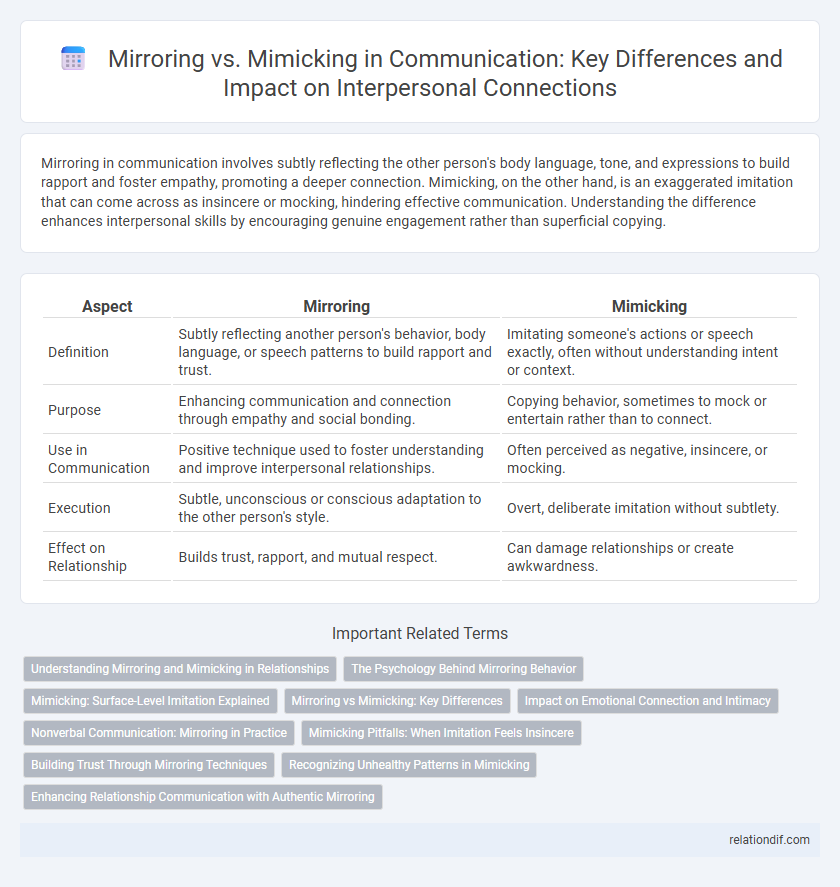Mirroring in communication involves subtly reflecting the other person's body language, tone, and expressions to build rapport and foster empathy, promoting a deeper connection. Mimicking, on the other hand, is an exaggerated imitation that can come across as insincere or mocking, hindering effective communication. Understanding the difference enhances interpersonal skills by encouraging genuine engagement rather than superficial copying.
Table of Comparison
| Aspect | Mirroring | Mimicking |
|---|---|---|
| Definition | Subtly reflecting another person's behavior, body language, or speech patterns to build rapport and trust. | Imitating someone's actions or speech exactly, often without understanding intent or context. |
| Purpose | Enhancing communication and connection through empathy and social bonding. | Copying behavior, sometimes to mock or entertain rather than to connect. |
| Use in Communication | Positive technique used to foster understanding and improve interpersonal relationships. | Often perceived as negative, insincere, or mocking. |
| Execution | Subtle, unconscious or conscious adaptation to the other person's style. | Overt, deliberate imitation without subtlety. |
| Effect on Relationship | Builds trust, rapport, and mutual respect. | Can damage relationships or create awkwardness. |
Understanding Mirroring and Mimicking in Relationships
Mirroring involves subtly reflecting a partner's emotions, body language, and speech patterns to build rapport and deepen emotional connection, while mimicking often implies copying behavior in a superficial or insincere manner. Understanding mirroring in relationships enhances empathy and trust, fostering authentic communication, whereas mimicking can lead to misunderstandings and perceived manipulation. Effective use of mirroring promotes emotional attunement, making partners feel seen and valued without losing individuality.
The Psychology Behind Mirroring Behavior
Mirroring behavior in communication involves subconsciously reflecting another person's body language, tone, and speech patterns to build rapport and foster trust. Psychological studies reveal that mirroring activates mirror neurons in the brain, enhancing empathy and social bonding by creating a sense of understanding and shared experience. Unlike mimicking, which is often perceived as insincere or mocking, mirroring is an empathetic and natural mechanism that facilitates smoother interpersonal interactions and effective communication.
Mimicking: Surface-Level Imitation Explained
Mimicking involves surface-level imitation where individuals replicate body language, tone, or speech patterns without understanding underlying emotions or intentions. This behavior often appears mechanical and can be perceived as insincere, lacking the emotional connection that genuine communication requires. Unlike mirroring, mimicking focuses solely on external behaviors rather than fostering authentic rapport or empathy in interpersonal interactions.
Mirroring vs Mimicking: Key Differences
Mirroring involves subtly reflecting another person's body language, tone, and emotions to build rapport and foster understanding in communication, whereas mimicking replicates these behaviors more overtly and often leads to discomfort or perceived insincerity. Mirroring is an empathetic technique used to enhance connection by aligning nonverbal cues naturally, while mimicking can come across as copying and may hinder authentic interaction. Key differences lie in intent, subtlety, and emotional impact, making mirroring a strategic tool for effective communication and mimicking a less effective mimicry.
Impact on Emotional Connection and Intimacy
Mirroring fosters genuine emotional connection by subtly reflecting a partner's body language and tone, enhancing empathy and mutual understanding. Mimicking, often seen as shallow imitation, can disrupt intimacy by creating discomfort or perceived insincerity. Effective communication benefits from mirroring's ability to build trust, whereas mimicking risks undermining authentic relational bonds.
Nonverbal Communication: Mirroring in Practice
Mirroring in nonverbal communication involves subtly reflecting another person's body language, gestures, and facial expressions to build rapport and enhance connection. Unlike mimicking, which often appears exaggerated or insincere, effective mirroring fosters trust and empathy by aligning with the other person's natural behavior. Research shows that this technique activates mirror neurons, facilitating deeper understanding and smoother interpersonal interactions.
Mimicking Pitfalls: When Imitation Feels Insincere
Mimicking in communication often leads to pitfalls when imitation feels insincere, causing discomfort and mistrust in interactions. Unlike mirroring, which subtly reflects body language to build rapport, mimicking exaggerates gestures or speech patterns, resulting in perceived mockery or awkwardness. Effective communication requires genuine responsiveness rather than mechanical replication to foster authentic connections.
Building Trust Through Mirroring Techniques
Mirroring involves subtly reflecting a person's body language, tone, and speech patterns to build rapport and foster trust in communication. This technique creates a sense of empathy and understanding, encouraging openness and cooperation between individuals. Unlike mimicking, which can appear insincere or mocking, authentic mirroring enhances interpersonal connections by promoting comfort and mutual respect.
Recognizing Unhealthy Patterns in Mimicking
Mimicking in communication often leads to unhealthy patterns such as loss of authenticity and increased interpersonal tension, as individuals replicate behaviors without genuine understanding or intent. This contrasts with mirroring, which involves subtle, empathetic reflection of body language and tone, fostering connection and trust. Identifying excessive or inappropriate mimicking is crucial to maintaining effective, sincere communication and avoiding emotional disconnect or manipulative interactions.
Enhancing Relationship Communication with Authentic Mirroring
Authentic mirroring in communication involves reflecting a partner's emotions and expressions genuinely, fostering trust and empathy in relationships. Unlike mimicking, which superficially copies behavior, mirroring emphasizes understanding and validation, deepening emotional connection. This approach improves dialogue effectiveness by creating a safe space for open, honest exchanges and mutual respect.
Mirroring vs Mimicking Infographic

 relationdif.com
relationdif.com